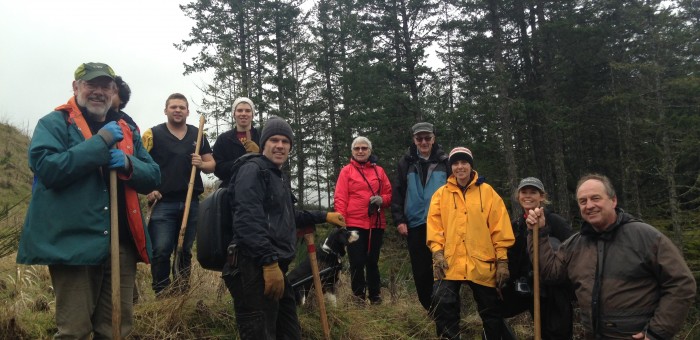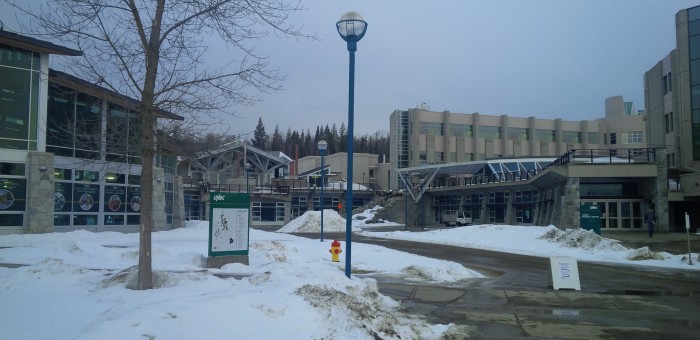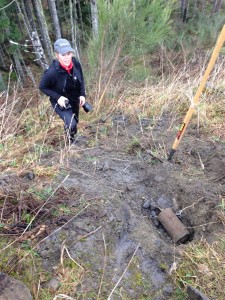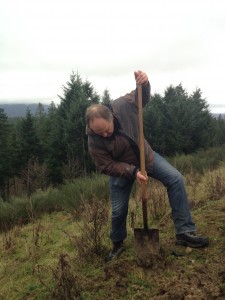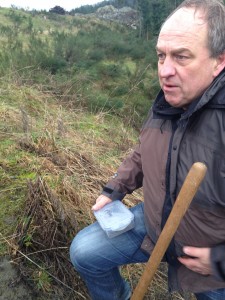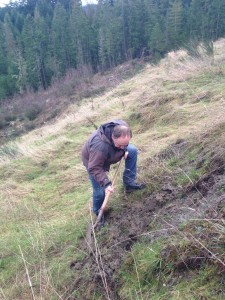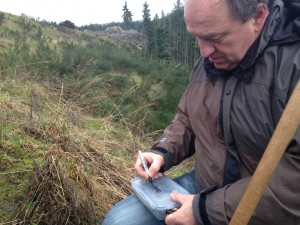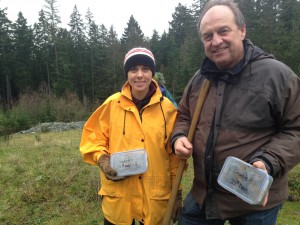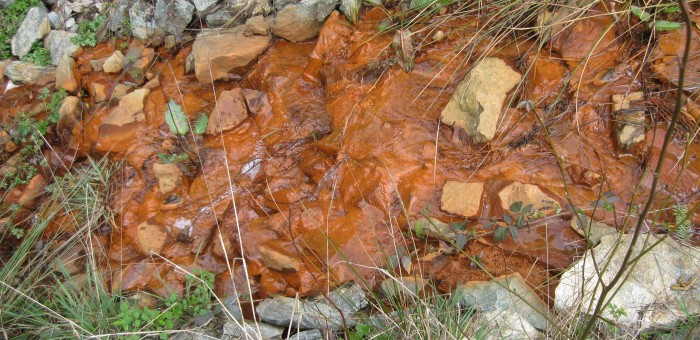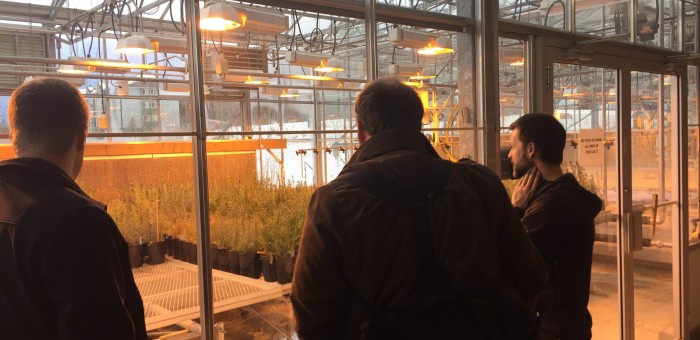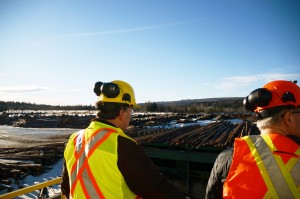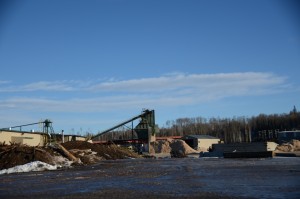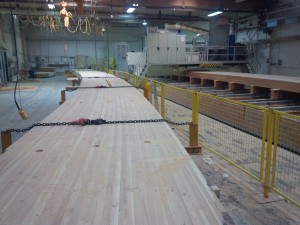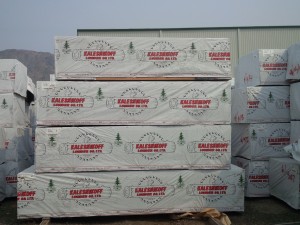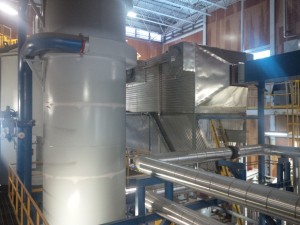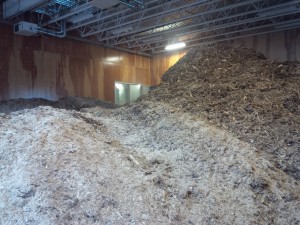Mining
Shawnigan Lot 21 Soil Sample Results
Late last week I received the results from the soil samples I collected on Lot 21 during the period that title reverted to the Crown.
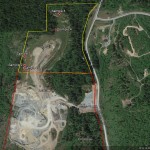 As I discussed earlier, I collected a total of fives samples from five separate locations on Lot 21 (see image above left for precise locations). Since automated drilling instruments were not allowed under FLNRO policy on Crown Land Use Policy, we used shovels to dig the five samples at depths of 28″, 14″, 15″, 22″ and 0″, respectively,
As I discussed earlier, I collected a total of fives samples from five separate locations on Lot 21 (see image above left for precise locations). Since automated drilling instruments were not allowed under FLNRO policy on Crown Land Use Policy, we used shovels to dig the five samples at depths of 28″, 14″, 15″, 22″ and 0″, respectively,
The soil samples were analysed by Maxxam Analytics for Volatile Organic, Total Hydrocarbon and Elemental Metal analyses. The results are now available. While I recognize that my approach of taking a few samples is a bit like looking for a needle in a hay stack, the good news is that both volatile organic and total hydrocarbon content were below detectable levels in all samples.
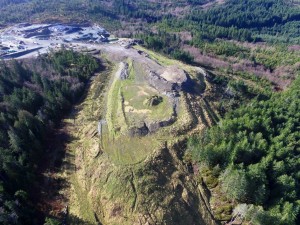 As indicated in the Residential/Parkland column of the Soil Quality Guidelines of the Canadian Council of Ministers of the Environment, the only sample that revealed above-recommended values was Sample #3. In this case both Zinc and Copper were over the guidelines.
As indicated in the Residential/Parkland column of the Soil Quality Guidelines of the Canadian Council of Ministers of the Environment, the only sample that revealed above-recommended values was Sample #3. In this case both Zinc and Copper were over the guidelines.
While my tests are by no means exhaustive and do not address the fundamental question as to what, if anything, is buried deep under the surface in Lot 21, they add to the body of knowledge concerning the area.
A Small Investment, a Boundless Return — Bringing Broadband Redundancy to Prince George
Earlier this month I toured the Prince George region to meet with a number of key stakeholders in the region. It became apparent from my visit that we have an incredible opportunity in British Columbia for continued innovation in our resource and tech sectors.
Prince George real estate is still reasonably priced, the surrounding environment is picturesque, there’s a first rate university in town. Prince George is a hub for northern BC and on the rail line from the Port of Prince Rupert to Chicago, one of greatest, if not the greatest, rail distribution centres in North America.
So what is missing? Why is there not a thriving and expanding hub of local technological innovation in partnership with the resource, forestry and agricultural sectors and capitalizing on the research expertise at UNBC? Why wouldn’t companies that are concerned about access to renewable energy, a skilled workforce and being able to attract and retain their workers not setup in Prince George? They’re located on the railway connecting Chicago’s North American rail distribution centre to Prince Rupert, a gateway to Asian markets.
The answer is simple. Broadband redundancy in the region precludes major investments in this area.
Today in the legislature I rose to question the Minister of Technology, Innovation and Citizen Services about government’s plans to introduce broadband redundancy in Prince George.
Question
A. Weaver: I wish to thank the members opposite for applauding my introduction of my question again.
It’s become perfectly clear to everyone in this House — and, frankly, everyone in British Columbia — that this government’s plans for LNG have been nothing short of a monumental failure. There’s no backup plan. The government is void of ideas and in desperate need of help.
As leader of the B.C. Green Party, a party that cares about social, economic and environmental prosperity for all British Columbians, I visited Prince George earlier this month. I was struck by the potential for this region.
Prince George is a home of a first-class research university, the hub for northern B.C.’s forestry and natural resource sectors and is on the rail line from Port of Prince Rupert to Chicago, one of the greatest distribution centres in North America. The cooler climate of Prince George, relative to other jurisdictions on the west coast, also offers it certain unique advantages.
My question to the Minister of Technology, Innovation and Citizens’ Services is simple. Has this government considered providing broadband redundancy for the Prince George region
Answer
Hon. A. Virk: I’d like to thank the member from Oak Bay for his leadership, first of all, and for the question. The fact that he has gone to Prince George and recognized the great universities and the great north of British Columbia. Perhaps those to his right could learn from that leadership and go realize that there’s more to this province than those four or eight or ten square blocks in downtown Vancouver.
But I digress. The question that the member for Oak Bay–Gordon Head poses…. I’ve had staff, in fact, look into that. There are actually multiple backbone fibre lines to Prince George — up 97, east on Highway 16 and south on Highway 5. So there are redundancy lines to Prince George.
We’re going to continue to work on connectivity all across the province. If the member so wishes, I can certainly have him have a briefing with our connectivity experts at his earliest availability.
Supplementary Question
A. Weaver: In fact, the broadband redundancy does not exist in Prince George as we speak. Bringing the typically urban-based tech and the typically rural-based resource sector together, through partnership and innovation, will play a vital role in a 21st century economy that builds on British Columbia’s strategic advantage.
Prince George is an obvious strategic location for such growth, but in order for this to happen, it’s critical that broadband redundancy exist in the region — high-speed broadband redundancy. The government launched a $5 million ad campaign promoting its actions this past November. But instead of the slogan “Our opportunity is here,” the government could actually create that opportunity in investing in needed infrastructure to benefit B.C.’s northern communities.
At $20,000 to $25,000 per kilometre, a 300-kilometre distance from Prince George to Chetwynd would cost a mere $6 million to $7.5 million to lay. Tech investors, data distribution centres and other innovators will not invest substantively in Prince George until broadband redundancy exists. The best part about this opportunity is that the cost to government is small and the potential benefits are unbounded.
To the Minister of Technology, Innovation and Citizens’ Services, my question is simple. Will the government commit to invest the $6 million to $7.5 million, today, required to ensure high-speed broadband redundancy for Prince George and real, sustainable and diversified economic prosperity to the north? And, if not, why not?
Answer
Hon. A. Virk: I know that the members from Prince George and members of the rural caucus certainly applaud the member for Oak Bay–Gordon Head in terms of his continued interest in rural British Columbia and continued interest in the north.
As I said, there is multiple backbone fibre lines to Prince George, but let’s look beyond that. The member will certainly recall the additional $10 million committed to increase connectivity all across British Columbia. We’re at 94 percent. We’re at 94 percent right now; 94 percent of British Columbians currently have access to high-speed Internet — considered in today’s technology environment.
We are committed to ensuring that every single British Columbian is connected to high-speed Internet because it’s become a stable item. We are committed that every single person in British Columbia by 2021 has access to high-speed Internet.
Video of Question Period
Media Release
Media Release: February 25, 2016
Andrew Weaver – Tech investment in Northern BC lacking
For immediate release
Victoria B.C. – Andrew Weaver, Leader of the B.C. Green Party and MLA for Oak Bay-Gordon Head, today offered government an untapped opportunity for job creation and technological innovation in northern British Columbia through the introduction of broadband redundancy into the region.
Prince George is home to a first class research university, the hub for northern BC’s forestry and natural resource sectors, and on the rail line from the Port of Prince Rupert to Chicago, one of greatest rail distribution centres in North America. The cooler climate of Prince George, relative to other jurisdictions on the west coast, also offers unique advantages for data centres.
“Bringing the typically urban-based tech and typically rural-based resource sectors together through partnership and innovation will play a vital role in building a 21st century economy that builds on British Columbia’s strategic advantages,” says Weaver. “In order for these to be possible, it is critical that broadband internet redundancy be brought to the region. This means investing in another line of broadband connectivity for Prince George.”
Broadband redundancy is when a city has at least two lines of connectivity to the rest of the world. Currently Prince George only has one direct highspeed line to Vancouver.
“Tech investors, data distribution centres, and other innovators will not invest substantively in Prince George until the infrastructure is there,” says Weaver. “The best part about this opportunity is that the cost to government is negligible and the potential benefits are unbounded.”
At a cost of about $20,000 to $25,000 per kilometre, the 300 km distance connecting Prince George to Chetwynd would cost between $6 million and $7.5 million to lay.
Telus invested $75m in a new data centre in Kamloops which opened in 2014.
“The fact that Kamloops has broadband redundancy is one of the key reasons they invested $75 million in a new data centre,” says Weaver. “This is just one example of the potential opportunities that could exist.”
Andrew Weaver asked the Minister of Technology and Innovation if he would support an investment in broadband redundancy for the city of Prince George today in Question Period.
-30-
Media contact
Mat Wright
Press Secretary – Andrew Weaver MLA
Cell: 250 216 3382
Mat.wright@leg.bc.ca
Twitter: @MatVic
Parliament Buildings
Room 027C
Victoria BC V8V 1X4
Eagerly Awaiting the Results of Lot 21 Soil Samples
 Last Monday I noted that the Crown was now the new owner of Lot 21, c/o the surveyor of taxes. Lot 21, of course, is the property located immediately beside the site of the contaminated soil facility operating in the Shawnigan Lake watershed.
Last Monday I noted that the Crown was now the new owner of Lot 21, c/o the surveyor of taxes. Lot 21, of course, is the property located immediately beside the site of the contaminated soil facility operating in the Shawnigan Lake watershed.
In a media release that I issued on that day (February 15), I argued that the government no longer had any excuses to prevent it from thoroughly investigating the property. The government had previously told to me that drilling was not possible as the site was private property. But since Lot 21 returned to the Crown, I called upon government to undertake drilling to ensure residents, local and provincial governments and First Nations knew what, if anything, was buried on the site.
 Doing so would have put an end to speculation circulating in a prevalence of anecdotal stories. It would also have allowed the following question I had previously been left with to be answered directly:
Doing so would have put an end to speculation circulating in a prevalence of anecdotal stories. It would also have allowed the following question I had previously been left with to be answered directly:
What, if anything, has been buried on Lot 21 that could produce the Thorium, Lead and other heavy metal enrichment in the sediments?
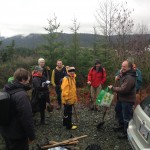 To my disappointment, the government failed to show the initiative to seek an answer to this question. As such, in order to address the concerns of my constituents who have property on Shawnigan Lake, I was forced to collect samples myself. And so, at 09:00 on February 19, my legislative assistant Aldous Sperl and I set off to the area to collect five soil samples.
To my disappointment, the government failed to show the initiative to seek an answer to this question. As such, in order to address the concerns of my constituents who have property on Shawnigan Lake, I was forced to collect samples myself. And so, at 09:00 on February 19, my legislative assistant Aldous Sperl and I set off to the area to collect five soil samples.
Upon our arrival at Stebbings Road we were greeted by a small group of local volunteers who were keen to help us out. Armed only with shovels, we set off on a several hundred metre hike to Lot 21.
 This must have been the fourth or fifth time that I have now hiked along the boundary of Lot 23 (containing the contaminated soil facility). On this particular journey, while fondly remembering my first and rather more difficult hike, I remarked how there was now a well worn path that had been created on the CVRD parkland. It seems that the route has now become oft travelled path.
This must have been the fourth or fifth time that I have now hiked along the boundary of Lot 23 (containing the contaminated soil facility). On this particular journey, while fondly remembering my first and rather more difficult hike, I remarked how there was now a well worn path that had been created on the CVRD parkland. It seems that the route has now become oft travelled path.
Prior to setting out on our journey my legislature office checked with the Ministry of Forests Lands and Natural Resource Operations (FLNRO) to ensure that there were no regulations prohibiting us from collecting soil samples. The Ministry directed us to FLNRO policy on Crown Land Use Policy that specifically stated, under section 6.2.3.3 Investigative Activities on Crown Land that:
Given the green light that we were given by FLNRO, Aldous, CVRD Director Sonia Furstenau and I set out to collect a total of fives samples from five separate locations on Lot 21 (see image above left for precise locations). Since automated drilling instruments were not allowed under FLNRO policy, we used shovels to dig the five samples at depths of 28″, 14″, 15″, 22″ and 0″, respectively,
Early on in our sampling we discovered a rather odd metallic cylinder with a plastic tube emerging from it (above left). As we felt that it was important to clean any debris off crown land, one of the local volunteers picked the cylinder up to examine and dispose of it at a later date. All holes that I dug were carefully refilled to ensure no disruption to “natural habitat” in the area.
Today I dropped off my soil samples at Maxxam Analytics for Volatile Organic, Total Hydrocarbon and Elemental Metal analyses. I expect results on Wednesday next week and I will report back immediately upon their receipt.
Shawnigan Lake: Questions Keep Mounting — the Latest Twist
On the day the judicial review of the process that led to the permitting of a contaminated soil facility in the Shawnigan Lake watershed begins, a new twist has occurred. In what has become the next chapter of the never ending saga, new information now reveals that as of February 5th, the Crown is now the new owner of Lot 21, c/o the surveyor of taxes.
Recall that back in April of last year, when I first wrote about this issue, I highlighted some concerns regarding what could have been buried upstream of the orange runoff that I took water samples of. My concern was amplified when I tested the metal content in the sediments underlying the orange water in July, 2015.
After examining the elemental sediment analysis, I was left with a number of serious concerns. The enriched metal values in the sediments under the runoff suggested that their source came from somewhere upstream and likely within Lot 21 itself. The question I was left with was this:
What, if anything, has been buried on Lot 21 that could produce the Thorium, Lead and other heavy metal enrichment in the sediments?
In subsequent discussions with the Ministry, I asked if they would consider drilling Lot 21 to determine what is buried beneath the surface. Doing so would put an end to speculation circulating in a prevalence of anecdotal stories. It would also allow the above question to be answered directly.
One of the reasons I was given that the government could not do this was that it was private land. Well now that is no longer the case. So the question is this:.
Will the BC Government drill Lot 21 to determine what, if anything, has been buried there?
The government has now simply run out of excuses for not doing so.
Media Release
Media Statement February 15, 2016
No excuses left: Lot 21 title change means Government must investigate Shawnigan site
For immediate release
Victoria B.C. – The recent news that the title for Lot 21 near Shawnigan Lake, next to the disputed contaminated soil dump site, has reverted from 0782484 BC Ltd. to the Crown means that the government no longer has any excuses to prevent it from thoroughly investigating the property.
Andrew Weaver, MLA for Oak Bay Gordon Head and Leader of the B.C. Green Party, is calling on the Ministry of Environment to drill to bedrock to determine what, if anything, has been buried on Lot 21 that could produce previously observed heavy metal enrichment in the sediments below runoff from this site?
The government has previously argued that drilling was not possible as the site was private property. Now that Lot 21 has returned to the Crown, Andrew Weaver is calling for drilling to ensure residents, local and provincial governments and First Nations know what is buried in the site. Doing so would put an end to speculation circulating in a prevalence of anecdotal stories. It would also allow the above question to be answered directly.
“The fact that Lot 21 has reverted to Her Majesty the Queen in Right of the Province of British Columbia c/o Surveyor of Taxes means that the government now has no legal or legislative obstacle to thoroughly investigate what may be buried on that property. They own it. There is no excuse, the government should begin inspection drilling immediately.” says Andrew Weaver.
-30-
Media Contact
Mat Wright
Press Secretary – Andrew Weaver MLA
Cell: 250 216 3382
Mat.wright@leg.bc.ca
Twitter: @MatVic
Parliament Buildings
Room 027C
Victoria BC V8V 1X4
On Innovation in the Resource Sector in BC — the Potential is Huge
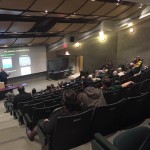 Two weeks ago I visited Prince George to meet with a number of key stakeholders in the region. The purpose of my trip was threefold. First, on my way to Prince George I passed through Kelowna where I participated in a panel at the Western Silvicultural Contractors’ Association (WSCA) 35th Annual Conference, Tradeshow & AGM. Second, I had accepted an invitation by Spruce City Wildlife Association to participate in a political panel at the University of Northern British Columbia on hunting and wildlife conservation. Third, I arranged meetings with local councilors and business leaders to learn more about the existing and potential future economic opportunities in region. I also gave a lecture on carbon pricing, clean energy and LNG in Dr. Kyrke Gaudreau‘s Carbon Neutrality ENVS498/NRES 798 class, and accepted an invitation from the Pacific Institute for Climate Solutions at UNBC to give a public lecture on science and politics in the evening of Friday, February 5th.
Two weeks ago I visited Prince George to meet with a number of key stakeholders in the region. The purpose of my trip was threefold. First, on my way to Prince George I passed through Kelowna where I participated in a panel at the Western Silvicultural Contractors’ Association (WSCA) 35th Annual Conference, Tradeshow & AGM. Second, I had accepted an invitation by Spruce City Wildlife Association to participate in a political panel at the University of Northern British Columbia on hunting and wildlife conservation. Third, I arranged meetings with local councilors and business leaders to learn more about the existing and potential future economic opportunities in region. I also gave a lecture on carbon pricing, clean energy and LNG in Dr. Kyrke Gaudreau‘s Carbon Neutrality ENVS498/NRES 798 class, and accepted an invitation from the Pacific Institute for Climate Solutions at UNBC to give a public lecture on science and politics in the evening of Friday, February 5th.
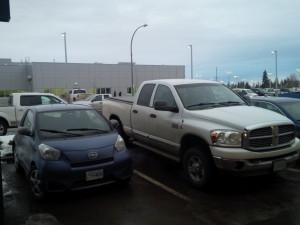 Before proceeding I’d like to point out how unusual the weather was. It got as high as 7°C while I was there and the 10mm of rain that fell during the 5th was enough to clear away much of the snow. While not a normal Prince George winter’s day, it was perfect weather for driving my rented Toyota Scion iQ which seemed a little out of place beside some of the picture cars in the area.
Before proceeding I’d like to point out how unusual the weather was. It got as high as 7°C while I was there and the 10mm of rain that fell during the 5th was enough to clear away much of the snow. While not a normal Prince George winter’s day, it was perfect weather for driving my rented Toyota Scion iQ which seemed a little out of place beside some of the picture cars in the area.
As you will see below, we have an incredible opportunity in British Columbia for continued innovation in our resource and tech sectors.
1: WSCA 35th Annual Conference
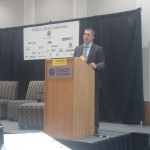 The Western Silvicultural Contractor’s Association is an organization that represents individuals and companies that serve as contractors for the Silvicuture Industry — an industry involved in the growing as cultivation of trees. As noted on their website, these individuals and companies:
The Western Silvicultural Contractor’s Association is an organization that represents individuals and companies that serve as contractors for the Silvicuture Industry — an industry involved in the growing as cultivation of trees. As noted on their website, these individuals and companies:
“grow seedlings, plant trees, tend stands, brush plantations, fight wild fires, prepare planting sites, survey forest regeneration, burn slash piles and restore forest and range ecosystems.”
I participated in the plenary panel: Forestry Policy Panel to answer: What’s the Big Idea? The guiding question was “What is the forestry goal in the post-mountain-beetle-increasingly-intense-wildfire-season-pending-climate-change-looming-timber-shortfall world we are heading into and where does silviculture fit into it?”
 Independent Forester Bill Dumont from the Forest Practices Board, Ian Meier, Director, BC Wildfire Services, and Bob Fleet, VP, Environment & Forestry, Tolko Industries Ltd, joined me on the panel. The goal of the panel was to stimulate big picture challenges and opportunities within the forest sector in the years ahead.
Independent Forester Bill Dumont from the Forest Practices Board, Ian Meier, Director, BC Wildfire Services, and Bob Fleet, VP, Environment & Forestry, Tolko Industries Ltd, joined me on the panel. The goal of the panel was to stimulate big picture challenges and opportunities within the forest sector in the years ahead.
The focus of my presentation was on the challenges and opportunities arising from global warming. The conversation initially focused on the increasing likelihood of extreme precipitation, larger-area wildfires, summer drought, extreme temperatures and what this might mean for forestry. I pointed out that the challenges of global warming will also lead to opportunities. But if we want to capitalize on these opportunities BC and Canada need to invest more heavily in research within the government and academic sectors.
In addition, I outlined potential opportunities for innovation within the forest sector that could arise through partnership between the forest sector and BC’s vibrant tech sector (see more below). To conclude, I recommended that those interested in this area consider reading the book by Stefan Heck and Matt Rogers entitled Resource Revolution: How to Capture the Biggest Business Opportunity in a Century.
All in all, it was a fascinating event and I was honoured to have the opportunity to serve on the same panel as the other panelists.
2: Spruce City Wildlife Association Symposium
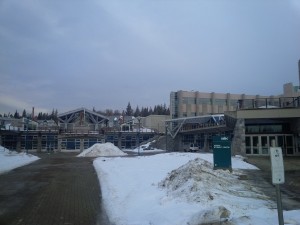 As many who follow this blog will know, I have written extensively about wildlife conservation, habitat protection, hunting and the rights of resident hunters over the last year. One of the issues I have been concerned with is the allocation of hunting permits between guide outfitters and resident hunters. I’ve also spoken out strongly against trophy hunting and I’ve introduced two private member’s bills in an attempt to end this practice.
As many who follow this blog will know, I have written extensively about wildlife conservation, habitat protection, hunting and the rights of resident hunters over the last year. One of the issues I have been concerned with is the allocation of hunting permits between guide outfitters and resident hunters. I’ve also spoken out strongly against trophy hunting and I’ve introduced two private member’s bills in an attempt to end this practice.
Over the last year I’ve engaged in countless on-line conversations with hunters, environmentalists and regular folk just seeking clarification as to the intent of my bills and blog posts. What has become abundantly clear to me is that concerned urban environmentalists and hunters share more commonalities than they do differences. First and foremost is that both groups are committed to supporting conservation.
 Second, I have found that the overwhelming majority of people I have spoken with support a science-based, ecosystem-based approach to wildlife (and forestry/natural resource-based) management. In so doing we end up as a society grappling with ethical questions like is it justifiable to kill one animal in the name of saving another? What if one of those animals is endangered? Predator management in certain cases is fundamental to wildlife management for it is unrealistic for us to think that humans have not disturbed the habitat in which the wildlife live. Some might argue that we should let nature take its course. I would respond that this would be inconsistent with a science-based, ecosystem-based approach to wildlife management as we have already disturbed all aspects of nature.
Second, I have found that the overwhelming majority of people I have spoken with support a science-based, ecosystem-based approach to wildlife (and forestry/natural resource-based) management. In so doing we end up as a society grappling with ethical questions like is it justifiable to kill one animal in the name of saving another? What if one of those animals is endangered? Predator management in certain cases is fundamental to wildlife management for it is unrealistic for us to think that humans have not disturbed the habitat in which the wildlife live. Some might argue that we should let nature take its course. I would respond that this would be inconsistent with a science-based, ecosystem-based approach to wildlife management as we have already disturbed all aspects of nature.
Third I have realized that the term “trophy hunting” has a different meaning to hunters compared to what is commonly understood in urban areas. For many, including me, trophy hunting means hunting exclusively for a trophy (head, skin or antlers) with no intention of packing out the meat to your home. Guide outfitters can offer foreigners the opportunity to come to BC and kill an animal. The meat could either be given away (or left to rot in the case of grizzlies) and all that the foreign hunter takes home is the trophy. It is this that the overwhelming majority of British Columbians, including resident hunters, abhor. But to many hunters, trophy hunting means hunting a trophy animal. It’s a bit like trophy fishing. The trophy fish is a big fish; it’s a keeper, not one you catch and release. Sure the antlers will come out, but so will the organic, free-range meat which will be used to feed a family for many, many months.
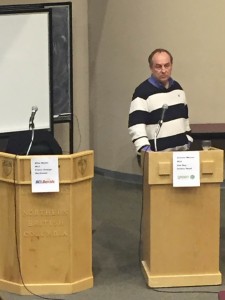 The purpose of the Spruce City Wildlife Association Symposium was to explore these issues more thoroughly with representatives from the four major political parties. Invitations went out at the end of November last year and I immediately accepted. Joining me on the panel were Katrine Conroy from the BC NDP, and Dan Brooks, Interim Leader of the BC Conservative Party. MLA Mike Morris (Prince George-Mackenzie) was also invited to attend but declined to do so just two days before the scheduled event. This was disappointing as he was in town on the day and no other Liberal MLA was dispatched to replace him either.
The purpose of the Spruce City Wildlife Association Symposium was to explore these issues more thoroughly with representatives from the four major political parties. Invitations went out at the end of November last year and I immediately accepted. Joining me on the panel were Katrine Conroy from the BC NDP, and Dan Brooks, Interim Leader of the BC Conservative Party. MLA Mike Morris (Prince George-Mackenzie) was also invited to attend but declined to do so just two days before the scheduled event. This was disappointing as he was in town on the day and no other Liberal MLA was dispatched to replace him either.
A number of the questions were given us in advance. These ranged from questions regarding grizzly bear hunting, to funding of wildlife management and restoration, to First Nation hunting rights. Neither Dan Brooks nor I prepared answers in advance. I was, however, disappointed to see Katrine Conroy read from prepared answers written and approved by the party. All in all it was clear to me that the audience was profoundly troubled with the direction British Columbia is heading both in terms of wildlife conservation and the rights of resident, versus foreign, hunters.
3: Technology and the Resource Sector in Prince George
During the morning I met with Oliver Ray, Executive Director of the North Central Local Government Association, Meghan Ginter, membership and events manager with the Prince George Chamber of Commerce and Prince George Councillor Jillian Merrick to learn more about the existing and potential future economic opportunities in region. We discussed how British Columbia could use our strategic advantage as a destination of choice to attract industry to BC in highly mobile sectors that have difficulty retaining employees in a competitive marketplace. In particular, we discussed the availability of our boundless renewable resources — energy, water and fibre — which could be used to attract industry that wants to brand itself as sustainable over its entire business cycle.
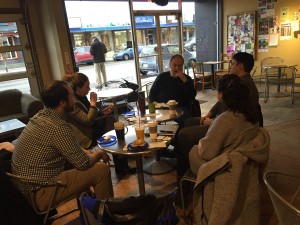 It’s just like what Washington has done. BMW announced an expansion to the Moses Lake carbon-fiber plant, which would see a tripling of its capacity. BMW uses the plant to produce carbon fiber ribbon employed in its i8 concept “sustainable car”. There are two hundred 21st century jobs from just this one investment alone. Oregon is also heading down this path. Google, a company that sees itself as a powerhouse of the 21st century wants to ensure it has access to clean, renewable energy. Oregon was able to provide Google with price certainty and so the company invested $1.2 billion in the creation of a major data distribution centre in The Dalles. And that’s another eighty 21st century jobs from another investment.
It’s just like what Washington has done. BMW announced an expansion to the Moses Lake carbon-fiber plant, which would see a tripling of its capacity. BMW uses the plant to produce carbon fiber ribbon employed in its i8 concept “sustainable car”. There are two hundred 21st century jobs from just this one investment alone. Oregon is also heading down this path. Google, a company that sees itself as a powerhouse of the 21st century wants to ensure it has access to clean, renewable energy. Oregon was able to provide Google with price certainty and so the company invested $1.2 billion in the creation of a major data distribution centre in The Dalles. And that’s another eighty 21st century jobs from another investment.
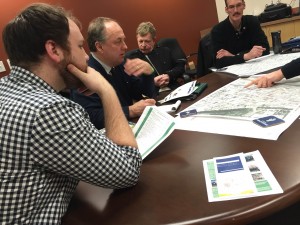 The cooler climate of Prince George, relative to other jurisdictions on the west coast, led me to ask if Prince George was exploring options like this. From our discussions, later reaffirmed when I met with Mayor Lyn Hall, Councillors Murray Krause, Garth Frizzell and district staff, it became clear to me that a barrier for this to occur is the lack of broadband redundancy in the region (see summary).
The cooler climate of Prince George, relative to other jurisdictions on the west coast, led me to ask if Prince George was exploring options like this. From our discussions, later reaffirmed when I met with Mayor Lyn Hall, Councillors Murray Krause, Garth Frizzell and district staff, it became clear to me that a barrier for this to occur is the lack of broadband redundancy in the region (see summary).
In our discussions I further emphasized that I believe it is critical that we bring the typically urban-based tech and typically rural-based resource sectors together. Innovation in technology will lead to more efficient and clever ways of operating in the mining and forestry industries. Earlier, Oliver Ray had also noted the importance and potential for the agricultural sector as well. And in addition to our natural resources, we would also have the potential to export innovation in the rapidly emerging knowledge-based economy. But once more, a barrier to building Prince George as a hub for natural resource/tech innovation is limited by the availability of broadband redundancy
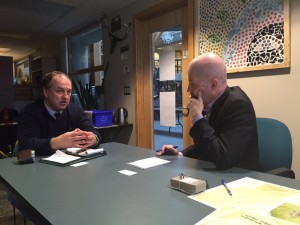 Recently, for instance, I learned about the story of a BC-based technology innovator (Minesense Technologies Ltd.) partnering with a local mine to dramatically improve the efficiency and environmental footprint of their mining operations. Rather than hauling thousands of unnecessary tonnes of rock for processing, the new technology allowed the rocks to be scanned for ore content on site. This meant that prior to trucking, the company could determine if it was more cost-effective to simply put the rock to one side for use as fill later.
Recently, for instance, I learned about the story of a BC-based technology innovator (Minesense Technologies Ltd.) partnering with a local mine to dramatically improve the efficiency and environmental footprint of their mining operations. Rather than hauling thousands of unnecessary tonnes of rock for processing, the new technology allowed the rocks to be scanned for ore content on site. This meant that prior to trucking, the company could determine if it was more cost-effective to simply put the rock to one side for use as fill later.
While in Prince George I was fortunate to be given a tour of the Carrier Lumber Ltd. Prince George mill 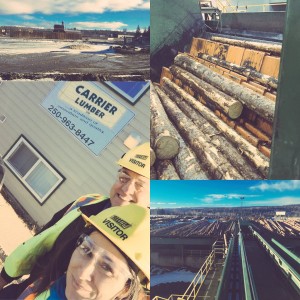 by its president, Bill Kordyban. Carrier Lumber is a family owned business that was started by Bill’s father in 1951. It wasn’t until 1976 that the facility at Prince George was built. The Prince George mill currently employs around 300 people, with the majority of workers being members of United Steelworkers Local 1-424. Carrier is one of a number of mills in the Prince George area but what is remarkable about this particular enterprise is the fact that the company is diversified.
by its president, Bill Kordyban. Carrier Lumber is a family owned business that was started by Bill’s father in 1951. It wasn’t until 1976 that the facility at Prince George was built. The Prince George mill currently employs around 300 people, with the majority of workers being members of United Steelworkers Local 1-424. Carrier is one of a number of mills in the Prince George area but what is remarkable about this particular enterprise is the fact that the company is diversified.
Carrier owns the Prince George Mill and another Mill in Saskatchewan. In addition, Carrier has its own fabrication shop situated in a 76,000 building a stone throw away from their Prince George mill. Being the largest fabrication shop in BC, the shop not only builds much of Carriers milling equipment, but it also builds for other industries in the area. The 8000 acre Bar-K ranch with over 2000 head of cattle is also part of the Carrier group of holdings.
During the tour, Bill was quick to point out that the “thing about saw mills is that it’s all about flexibility”, and it was abundantly clear that Carrier lumber has figured out how to compete in highly competitive forest products sector. State of the art technologies are used throughout the mill in order to maximize recovery of wood products. Every bit of fibre in each and every log is used one way or another. Logs are maximized for lumber production with each resulting board being marked with a unique serial numbered. Hog fuel arising from stripping the logs of bark is shipped to Canfor for use as a biofuel. Wood chips end up being used for pulp and paper and sawdust is sent to Premier Pellet Ltd in Vanderhoof to be converted into wood pellets. And of course there is lumber, which is produced at a rate of about 300 boards a minute.
Like other mills in the area, there is growing concern that as government reduces the allowable cut in the near future due to pine stands devastated by the Mountain Pine Beetle beginning to run out, it is done so as to allow both family-owned and larger multinational mills to survive. In addition, as negotiations proceed between Canada and the US about extending the Softwood Lumber Agreement, there is ongoing trepidation within the forestry sector across all of Canada. Given the importance of forestry to our economy, it’s critical that government ensure that it does what it can to ensure this sector remains vibrant.
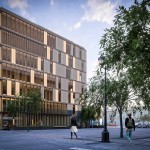 Innovation at the interface between technology and forestry not only extends to the production of lumber, but also to the value-added forest products sector as well. As Mayor Hall, Councillor Krause, and I set off to visit the Peaking Backup Energy Centre associated with the Prince George Downtown District Energy System, we stopped in to visit the award-winning Wood Innovation Design Centre (WIDC).
Innovation at the interface between technology and forestry not only extends to the production of lumber, but also to the value-added forest products sector as well. As Mayor Hall, Councillor Krause, and I set off to visit the Peaking Backup Energy Centre associated with the Prince George Downtown District Energy System, we stopped in to visit the award-winning Wood Innovation Design Centre (WIDC).
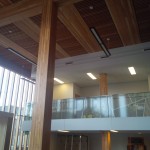 Completed on October 31, 2014, the WIDC is a six story building constructed entirely of wood, engineered wood and wood products. It is yet another marvellous example of innovation and creativity that arises when the resource and tech sectors are brought together. Upon entering the WIDC one is immediately greeted with the sweet aroma of wood and the stunning architecture. It would be an inspiring place to work and the University of Northern British Columbia obviously thinks so too.
Completed on October 31, 2014, the WIDC is a six story building constructed entirely of wood, engineered wood and wood products. It is yet another marvellous example of innovation and creativity that arises when the resource and tech sectors are brought together. Upon entering the WIDC one is immediately greeted with the sweet aroma of wood and the stunning architecture. It would be an inspiring place to work and the University of Northern British Columbia obviously thinks so too.
The WIDC is the home of UNBC’s Master of Engineering in Integrated Wood Design program, with an objective “designed to enhance the students’ understanding of wood as a versatile and sustainable building component.” In fact, I had wanted to visit the WIDC for quite some time as I was first learned about the building while visiting the Structurlam manufacturing facility in Okanagan Falls, during my September 2015 visit to the Okanagan.
Structurlam is an outstanding example of a BC based business in the value-added forest sector. Their two main products Glulam and Crosslam are 100% engineered-wood laminations that can be used as replacements in building construction for steel and cement, respectively. Structurlam played a key role in supplying product for the building of the WIDC. For those on southern Vancouver Island or in the Vancouver region, you can see their beautifully engineered products in one of the buildings below. In addition, Structurlam is presently manufacturing panels for UBC’s 18-story Brock Commons Student Residence which when completed will be the world’s tallest wood building.
 One of the things that impressed me during my tour of the Structurlam facility was their commitment to source lumber from BC-based companies. During my visit last September, vast quantities of ready-to-be-used lumber were on site. This lumber was used from Kaleshnikoff Lumber Co. Ltd., a family owned business located in Tarry’s BC (on Highway 3A between Castlegar and Nelson) that was started in the late 1930’s by the children of Doukhobour immigrants who came to Canada in 1911.
One of the things that impressed me during my tour of the Structurlam facility was their commitment to source lumber from BC-based companies. During my visit last September, vast quantities of ready-to-be-used lumber were on site. This lumber was used from Kaleshnikoff Lumber Co. Ltd., a family owned business located in Tarry’s BC (on Highway 3A between Castlegar and Nelson) that was started in the late 1930’s by the children of Doukhobour immigrants who came to Canada in 1911.
4: Clean Energy, Sustainability and Leadership in Prince George
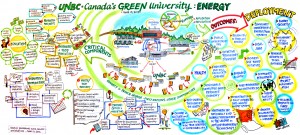 Prince George is home to the University of Northern British Columbia which in 2007 branded itself as Canada’s Green University™. With a name like that, you can bet I was thrilled to visit the campus, give a lecture in a class and tour their bioenergy facility. In fact, in 2015, and for the fourth year in a row, UNBC was listed as one of the Top 100 Canada’s Greenest Employers. To say I was impressed would be an understatement.
Prince George is home to the University of Northern British Columbia which in 2007 branded itself as Canada’s Green University™. With a name like that, you can bet I was thrilled to visit the campus, give a lecture in a class and tour their bioenergy facility. In fact, in 2015, and for the fourth year in a row, UNBC was listed as one of the Top 100 Canada’s Greenest Employers. To say I was impressed would be an understatement.
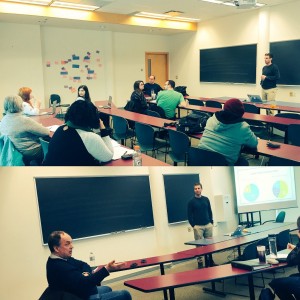 UNBC was recently ranked #1 in primarily undergraduate category of the annual Maclean’s university rankings and it was clear to me that the university has worked hard to deserve this reputation. I was taken on a tour of the bioenergy facility by University of Victoria engineering graduate David Claus, Assistant Director of Facilities Management.
UNBC was recently ranked #1 in primarily undergraduate category of the annual Maclean’s university rankings and it was clear to me that the university has worked hard to deserve this reputation. I was taken on a tour of the bioenergy facility by University of Victoria engineering graduate David Claus, Assistant Director of Facilities Management.
The bioenergy facility consists of a Nexterra Systems Corporation gasification system that became operational in May 2011. Powered entirely by wood waste (hog fuel) and housed in a LEED Platinum building, the bioenergy facility provides enough energy through its hot water distribution system to allow UNBC to reduce its consumption of fossil fuels for heating by 85%.
It’s not only UNBC that recognizes the potential to convert wood waste into heat. In fact, Prince George has also introduced its own district energy system that connects buildings downtown with a bioenergy facility at the nearby and newly rebuilt Lakeland Sawmill. Heated water at the Lakeland facility is piped underground to the downtown Peaking Backup Energy Centre. There distributions pumps and backup natural gas heating boilers are housed.
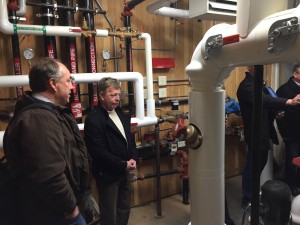 We were given a tour of the Peaking Backup Energy Centre by Todd Angus, Engineering Assistant, Public Works/Utilities. There he explained the functioning of the both the main and peaking backup systems. What’s remarkable is that the the underground hot water pipes transfer heat to numerous buildings in the downtown core including City Hall, the Coliseum arena, the Civic Centre, the Four Seasons pool, the library, the newly constructed RCMP building, the Two Rivers Art Gallery and the WIDC. Not only is this district heating system considered carbon neutral, it is also more efficient. The hot water heat exchangers are 99.9% efficient compared to typical ~80% for natural gas boilers.
We were given a tour of the Peaking Backup Energy Centre by Todd Angus, Engineering Assistant, Public Works/Utilities. There he explained the functioning of the both the main and peaking backup systems. What’s remarkable is that the the underground hot water pipes transfer heat to numerous buildings in the downtown core including City Hall, the Coliseum arena, the Civic Centre, the Four Seasons pool, the library, the newly constructed RCMP building, the Two Rivers Art Gallery and the WIDC. Not only is this district heating system considered carbon neutral, it is also more efficient. The hot water heat exchangers are 99.9% efficient compared to typical ~80% for natural gas boilers.
5: Summary
It became apparent from my visit to Prince George that the opportunities for the region are enormous. Real estate is still reasonably priced, the surrounding environment is picturesque, there’s a first rate university on site. Prince George is a hub for northern BC and on the rail line from the Port of Prince Rupert to Chicago, one of greatest, if not the greatest, rail distribution centres in North America.
So what is missing? Why would Google, for example, not jump at the idea of building a data distribution centre in Prince George? Why is there not a thriving and expanding hub of local technological innovation in partnership with the resource, forestry and agricultural sectors and capitalizing on the research expertise at UNBC? Why wouldn’t companies that are concerned about access to renewable energy, a skilled workforce and being able to attract and retain their workers not setup in Prince George? They’re located on the railway connecting Chicago’s North American rail distribution centre to Prince Rupert, a gateway to Asian markets.
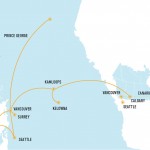 The answer is simple. Broadband redundancy in the region precludes major investments in this area.
The answer is simple. Broadband redundancy in the region precludes major investments in this area.
So what is broadband redundancy? The term broadband redundancy means that a community is not reliant upon a single high speed internet connect into their region. Prince George presently has a single high speed connection to the rest of North America via Vancouver. But if for some reason the line (between Prince George and Vancouver) goes down, Prince George is out of luck in terms of communicating at high speed with the rest of the world via the internet.
As you can see from the image to the left from BCNET, Kamloops has high speed internet connectivity to both Vancouver and Calgary. And so, if the Kamloops to Vancouver connection drops, redundancy is built in so high speed internet traffic can still go via Calgary. The fact that Kamloops has broadband redundancy is a a critical reason why TELUS recently built a $75 million data distribution centre there.
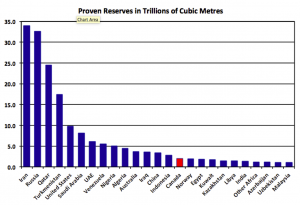 If government wants to stimulate the northern economy it should first stop throwing good money after bad ideas. I’ve been saying it for more than three years now, there will not be any significant development in LNG in BC anytime soon. The market is saturated; prices will remain low for many years; China already has more contracted supply than it actually need. China is now a seller in the marketplace. Add this to sanctions being lifted recently from the world’s largest natural gas reserve (Iran) and the proximity of the second largest reserve (Russia) to Asian markets with signed deals in place, and it should be clear that British Columbians have been misled by the government for quite some time about the future of LNG in this province.
If government wants to stimulate the northern economy it should first stop throwing good money after bad ideas. I’ve been saying it for more than three years now, there will not be any significant development in LNG in BC anytime soon. The market is saturated; prices will remain low for many years; China already has more contracted supply than it actually need. China is now a seller in the marketplace. Add this to sanctions being lifted recently from the world’s largest natural gas reserve (Iran) and the proximity of the second largest reserve (Russia) to Asian markets with signed deals in place, and it should be clear that British Columbians have been misled by the government for quite some time about the future of LNG in this province.
In my view, perhaps the single biggest stimulus to the area would be for government ensure that broadband redundancy is introduced to Prince George. And this would not be very expensive. After a number of meetings it was clear that what was needed was timely investment to connect Prince George to Chetwynd via high speed broadband. At a cost of about 20,000$ to 25,000$ per kilometre, the 300km distance would cost between $6 million and $7.5 million to lay. Yet the potential benefits would be enormous.
So while I am calling on the government to show leadership in this area now and invest in this critical infrastructure, I can ensure people in the area that if I were premier, it would be one of my top priorities.

